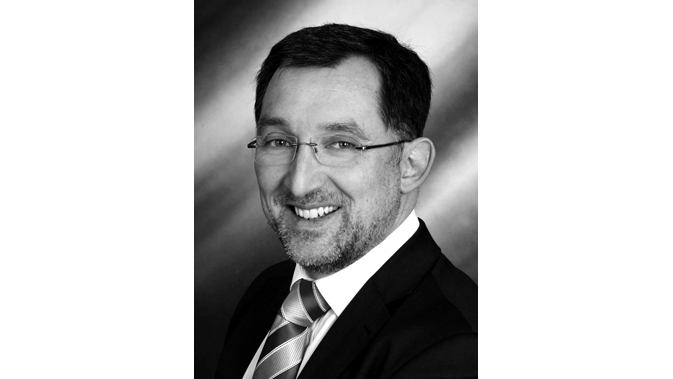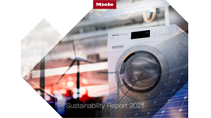Press releases
WetCare is increasingly becoming the standard for dry cleaners and their clients

25 years of wet cleaning with Miele and Kreussler: An double interview
The world's first wet-cleaning system celebrates 25 this year: What was first jointly presented by Miele and Kreussler in 1991 is today an integral part of modern textile care. Jürgen Schäfer, Chief Product Manager - Laundry Technology with Miele Professional, and Dr Helmut Eigen, Director of Textile Care at Kreussler, discuss milestones, trends and prospects.
Mr Schäfer, Dr Eigen, what makes the current WetCare system so different to the original 'Miele System Kreussler' dating back to 1991?
Jürgen Schäfer: In those early days, wet cleaning was perceived as an environmentally friendly alternative to avoid the use of much criticised solvents. Today, dry cleaners are familiar with a whole host of further benefits offered by WetCare, not least because an increasing number of delicate textiles can now be washed in water. In terms of the machines, the focus in 1991 was on a special-purpose washer-extractor with a 190-litre drum as we initially believed that this large drum could at best only be half-full. With the knowledge we had then, this was the only way to achieve the mechanical action necessary for good cleaning performance combined with the gentlest possible treatment of fabrics. In the meantime, our drums and the mechanics of washing have been perfected to such a degree that machines can now take a 60% load – despite improved cleaning performance and even gentler fabric care. The consequence is that we can now offer WetCare programmes on machines with a drum volume of 54 l upwards. These programmes therefore function on all washing machines from Miele Professional.
Dr Helmut Eigen: Something else that is new is the fact that wet cleaning has now become established in laundries in nursing homes. WetCare is the process of choice in tackling water-soluble soils such as food residue, fats and blood. It meets even the highest demands on cleanliness and hygiene, paired with the gentle treatment of woollens, silks and synthetics. One thing, though, has not changed since 1991: Miele and Kreussler are still central to a special partnership aimed at the thorough and gentle care of garments which were previously considered 'non-washable'. At the time of introduction, this was revolutionary and is still as valid today as ever before.
What were the special milestones along the way?
Dr Helmut Eigen: We have made continuous improvements to the process chemicals. Key progress was made for example with the introduction of more modern tenside formulations which combat fats and grease much better in the cold-wash temperature range. Today we use enzymes to remove vegetable and animal fats, for instance gravy stains. We have also made great progress in ensuring colour-fastness.
Jürgen Schäfer: The introduction of the patented Miele honeycomb drum to both washing machines and tumble dryers undoubtedly represents a milestone in process optimisation. Its sculptured pattern of hexagons and its small perforations brings maximum benefits in terms of gentle fabric care and remains to this day unique. Its efficacy has been endorsed by a series of independent tests carried out by wfk - Cleaning Technology Institute in Krefeld. Of course, on the customer side, increasing demand for easy-to-clean and hence washable textiles is forcing garment manufacturers' hands and much to our own benefit. Indeed, it makes our system even more attractive to commercial launderers.
What do you personally believe is the biggest competitive advantage of the WetCare system?
Dr Helmut Eigen: Our system does not use hazardous substances which need to be declared, is dermatologically tested and free from allergens. As a result, dry-cleaning operations based on the WetCare system can even be awarded Germany's 'Blue Angel' seal of approval.
Jürgen Schäfer: Other benefits of our system are the enhanced removal of water-soluble compounds, fragrantly fresh textiles and the option of disinfecting wet-cleaned clothing. An entire system can be installed with a minimum of effort as wet cleaning also works without steam heating and water softening. Furthermore, none of the numerous regulations which must be met by solvent-based systems apply here. In other words, our system offers a very broad range of applications to dry cleaners at little expense – covering virtually all textiles submitted by customers.
In what way do you provide support to laundries using WetCare?
Jürgen Schäfer: If customers so wish, our field staff can organise training courses for those operating the equipment, and they are also ready to help after machine commissioning with their expertise and advice. This can take the form of a maintenance or full service contract to ensure that machines are inspected and high-mortality parts replaced at regular intervals. If service is needed, Miele in Germany alone has around 160 technicians in the field who can provide prompt assistance.
Looking into your crystal ball, what trends do you foresee in the field of textiles? And what does that mean for the future of WetCare?
Jürgen Schäfer: Consumers are reacting with increasing sensitivity to environmental issues. Besides that, more and more fabrics are being labelled washable, driven by the demand from the market as I previously explained, but also because the textile industry is increasingly having to comply with regulations in their production processes. We at Miele are therefore convinced that laundering textiles in an aqueous system will continue to gain ground and that wet cleaning will become the standard within the next ten years. It will be crucial to see whether textile service providers are able to clearly communicate the benefits of wet cleaning to their potential customers. In this respect, Miele Professional has a contribution to make.
Dr Helmut Eigen: As fabrics are increasingly washable at low temperatures, processing and the requirements regarding both processes and products will be subject to change. We for our part have already adapted accordingly. In Miele Professional washing machines, we now use the new LANADOL DRY process in combination with our new product LANADOL X-press. As a result, our customers achieve even better results despite much shorter programme cycles – which also significantly improve productivity.
(1,010 words, 6,435 characters incl. spaces)
Company profile: Miele is the world's leading manufacturer of premium domestic appliances including cooking, baking and steam-cooking appliances, refrigeration products, coffee makers, dishwashers and laundry and floor care products. This line-up is augmented by dishwashers, washer-extractors and tumble dryers for commercial use as well as washer-disinfectors and sterilisers for use in medical and laboratory applications (Miele Professional). The Miele company, founded in 1899, has 8 production plants in Germany as well as one plant each in Austria, the Czech Republic, China and Romania. 2014/15 turnover amounted to approx. EUR 3.5 bn with sales outside Germany accounting for around 70%. Miele is represented with its own sales subsidiaries and via importers in almost 100 countries. The Miele company, now in the fourth generation of family ownership, employs a workforce of around 17,740, 10,350 thereof in Germany. The company headquarters are located in Gütersloh/Westphalia, Germany.
Download as PDF Download incl. media (zip)
Anke Schläger
+ 49 5241 89-1949
anke.schlaeger@miele.com
Media information
| Description | Download |
|---|---|

Jürgen Schäfer, Chief Product Manager - Laundry Technology with Miele Professional. |
High Resolution TIFF |
| High Resolution JPG | |

Dr Helmut Eigen, Director - Textile Care with Kreussler. (Photo: Kreussler) |
|
| High Resolution JPG |


